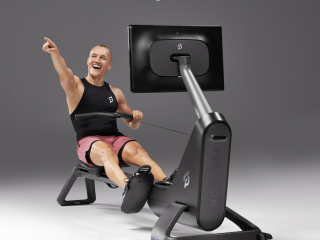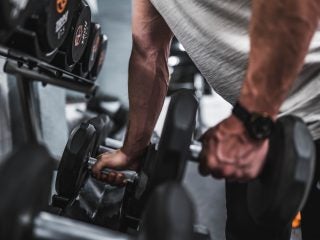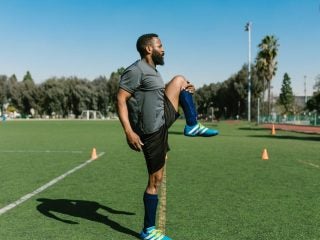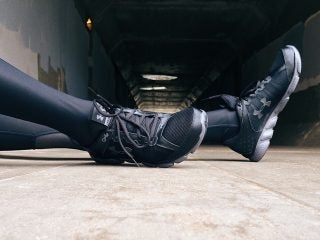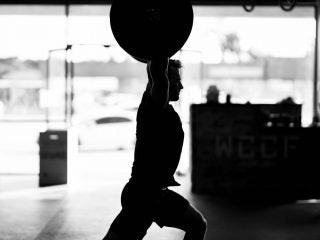Amino acid metabolism helps you build muscle mass, but this process is not a simple one because other factors are at work such as genetics, hormones and diet.
Your net protein balance is important when dealing with building muscle mass because you need to make more muscle protein than you break down.
It may be a bit difficult trying to build muscle mass after turning 50—especially since muscle degrades at a faster rate as you get older. And once this trend of degrading muscle starts, anabolic resistance starts to kick in. Although it takes a healthy diet and a lot of work to combat anabolic resistance when you get older, it’s possible to achieve.
What’s the Big Deal About Sarcopenia?
According to a 2014 article, about 29% of community-dwelling elderly have sarcopenia, and this number is higher for those that are hospitalized or undergoing long-term care.
Even though decreasing muscle mass starts as early as age 40, the intensity of that decline affects women and men differently. Therefore, a woman has a 20% greater chance of having sarcopenia.
Treating sarcopenia costs the health care system billions of dollars every year. Therefore, if you have sarcopenia and are hospitalized, your stay will be significantly higher, and the complications you may experience from treatment also increase.
Know the Symptoms
Muscle mass decrease is not the only sign of having sarcopenia. That’s why rebuilding muscle mass alone is not going to solve the problems associated with sarcopenia.
For starters, a decline in muscle endurance and mental decline occurs with sarcopenia. Other symptoms like dementia and depression are also common when people have sarcopenia. Deadly diseases are also sometimes a by-product of sarcopenia.
A lot of the biomarkers for sarcopenia involve the chemicals responsible for human immunity, growth and development and. Therefore, one can conclude that there are multiple biomarkers for sarcopenia since the body undergoes a transformation from muscle growth to muscle decline. Although there’s no explanation for why this transformation occurs, it doesn’t mean your biomarkers can’t be improved.
Know All the Consequences
Sarcopenia is just one of many health conditions a lot of elderly face. Some elderly are more likely to get diabetes, obesity, a physical disability, osteoporosis, and some succumb to hospitalization and death when having sarcopenia.
Because of the billions of dollars spent on treating sarcopenia, this condition absorbs at least 1.5 percent of all health care resources in the United States. Concurrent conditions like osteoporosis only intensify the strain on the healthcare system that sarcopenia causes.
Explore Your Treatment Options
Since there are a lot of treatment options to combat muscle decline, sarcopenia tends to be managed better than most other illnesses the elderly experience. However, using anabolic steroids does more harm than good when treating sarcopenia. The side effects of taking creatine supplements vary with each individual. Unfortunately, engaging in sports can cause severe injuries. Even natural methods like playing sports can lead to serious injuries.
Therefore, make sure you consult with your physician before trying to build muscle, so you can get the right diagnosis and the best (and safest) treatment option for your needs. Also, if there is another issue that’s causing the sarcopenia, your doctor can find that out, too.
Use Elastic Bands
Resistance exercises are great for overweight children because they are fun and they take away the stigma of doing exercise. A 2019 study examined how resistance exercise affects the elderly.
Participants were arranged in two groups: the placebo group and the treatment group. Those subjects in the treatment group participated in 3 one-hour resistance exercise events every week for 90 days. Compared to the placebo group, the treatment group gained lean muscle mass and improved their motor skills
Endurance Exercise
High-intensity interval training, (HIIT) has increased in popularity because it’s a weight-loss strategy. However, HIIT also builds muscle mass.
One study looked at the effect of endurance exercise on elderly participants involved in two 90-day intervals. The participants did their normal sedentary routine for one 90-day interval and did endurance exercise for the other 90-day interval.
During the HIIT interval, the participants rode a bike for 15 minutes three days per week and walked for 45 minutes two days per week.
After comparing the two intervals, the researchers discovered that although the participants increased their muscle mass, they didn’t increase their muscle endurance. Although these research participants didn’t experience any injuries people sometimes get hurt when doing HIIT. However, if you do some strengthening exercises and neuromuscular training, you will decrease your chances of getting injured while doing HIIT.
The Therapy of Recreational Games
Recreational games and offer a lot of promises for those with sarcopenia. According to a 2017 study, elderly who engage in recreational games and sports experience weight loss, improved sleep and improved health.
Another 2017 study examined the effect of recreational sports on building muscle mass for the elderly
Elderly men and women participated in a three-month duration of playing recreational sports. The treatment group either drunk a high-protein or low-protein shake, and the control group did not change their routine.
Not only did the treatment group increase their thigh muscle mass, but they also decreased their fat mass while improving their athletic abilities.
Increase Your Protein
Protein supplements are an athlete’s favourite solution for increasing muscle mass and muscle endurance. If used correctly, protein supplements make it easier to body build. You can now get protein powder in a variety of flavours.
Results from a 2015 study revealed that elderly adults need to consume a massive amount of protein to experience an anabolic effect from their protein intake. Another 2015 study tested the hypothesis on the impact of large amounts of protein on muscle mass in elderly participants. The treatment group consumed large amounts of protein with their meals two times a day for 60 days, and the control group consumed a placebo for the same duration. The results revealed leaner muscle tissue for the participants in the treatment group. Special protein powders like UltraMeal by Metagenics provide support for the nutritional management of patients with age-associated loss of skeletal muscle mass.
Take HMB Capsules
Trainers often tell bodybuilders to take HMB (beta-hydroxy beta-methyl butyric acid) capsules to increase muscle mass. The amino acid leucine facilitates muscle growth and prevents muscle breakdown, which are ideal traits to combat sarcopenia. A 2013 report in Clinical Nutrition examined the effect of HMB capsules on elderly people during bed rest.
For two weeks, the participants either took HMB capsules or a placebo On the fifth day, the participants were put on bed rest until the 15th day. The treatment group did not lose any muscle mass during bed rest, which is an amazing find because people often lose muscle mass—regardless of age—when they’ve spent at least 5 days of no movement.
More Vitamin D, Please
Although a variety of factors contribute to sarcopenia (and some are unknown), vitamin deficiency seems to be one of the main culprits promoting the condition. Vitamin D deficiencies can affect anybody regardless of age, but the elderly tend to die from a vitamin D deficiency compared to their younger counterparts.
The Journal of Clinical Endocrinology and Metabolism published a 2013 report about reversing a vitamin D deficiency. After finding participants with limited mobility and a vitamin D deficiency, the participants were either placed on a daily dose of 4,000 international units of vitamin D or placed on a placebo for four months. The results of the study revealed a 10.6 percent increase in muscle fibre size for the treatment group and a 7.4 percent decrease in muscle fibre size for the control group.
Electrical Myostimulation
More people are considering electrical myostimulation as a treatment for combating muscle deterioration. This procedure, which is often performed on young, healthy patients undergoing rehabilitation, was also tried on older adults in one 2013 study.
Researchers performed the procedure on elderly women who did little or no exercise three times (for 18 minutes) every two weeks for an entire year. The results revealed that the women in the treatment group experienced an increase in lean muscle, an increase in muscle endurance and a decrease in fat mass compared to the placebo group.
Consider Vibration Therapy
A more recent procedure involving muscle stimulation is called vibration therapy, which is just as effective as electrical myostimulation is at treating spinal cord injuries.
Because these treatments work differently, they can be combined to maximize your treatment for sarcopenia. Also, therapists have discovered that vibration therapy sometimes is the better option when there’s no success with electrical myostimulation.
A 2013 study on vibration therapy involved older men who did a 40-minute leg exercise while on standing on a vibrating platform. The exercise was done three times a week for a year. These participants saw an increase in thigh muscle mass and endurance. However, after resuming their normal routine, the results no longer remained after a year had gone by.
A Combo of Treatments
It is recommended you try both resistant exercises and nutritional supplements to maximize your chances of improving your muscle mass. To confirm this hypothesis, a 2015 study was published in the American Journal of Clinical Nutrition using overweight elderly men and women participants.
Participants reduced their calorie intake while exercising more for three months. The treatment group also took a supplement with leucine, vitamin D and whey protein, and the control group took a placebo. The results of the study revealed that both groups lost fat mass and weight. However, because the treatment group was able to maintain their muscle mass more than the placebo group, the researchers concluded that older adults could prevent sarcopenia while losing weight when doing the right combination of treatments.










